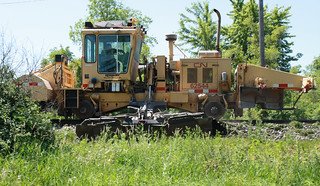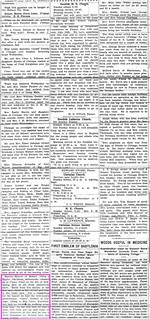It was a lovely summer morning, and there I was at my computer, cataloguing my microfilm notes, when I became aware of an approaching sound — a low, measured, rhythmic
thump … thump … thump … like the heartbeat of a sleeping universe that dreams only pleasant dreams.
As the thumping grew ever louder, I got up and went outside. Found out it wasn't actually the heartbeat of a sleeping universe that dreams only pleasant dreams. It was this thing:
 (Click on images to enlarge)
(Click on images to enlarge)This thing is a
ballast tamper. It's equipped on each side with quadruple pairs of prongs that end in flat paddles.

Those prongs plunge down into the ballast on both sides of each and every tie, to firm up the ballast under the tie. The slow thumping I heard was just the rhythm of raising and lowering the prongs, and I'm sure there was tremendous power behind each plunge down into the crushed rock.

The machine had to move with painful slowness, with a stop for each tie. Operating a ballast tamper must be an exercise in patience.
Afterwards, along comes this guy, with a
ballast regulator, who gets to move faster. On his first forward sweep, those adjustable wing-like plows on the side dig into the crushed rock and raise it up, along with any vegetation and dirt that has wandered among the rock. The whole side of the right-of-way gets a facelift.

The operator adjusts the angles of the plows and makes a second sweep backwards, doing the same thing in the other direction.

Then the side plows are raised up out of the way, and the rear plows come down for the next forward sweep.

Then all the plows get raised, the operators backs the machine up, and the final forward sweep is done with the big wire brush in front lowered, I suppose to clear rock fragments from the top surface of the ties. The spinning brush can send pieces of crushed rock flying five or ten feet, in spite of that protective hood.

Once the ballast regulator did its thing, I thought the show was over. I went back in the house.
After a time, the house began to shake — worse than the ballast tamper had shaken it, worse than any 40-mile-per-hour freight train ever shook it. The windows rattled, the walls hummed, the foundation vibrated.
I went outside again, to find this weird thing:

It's big, all right, but it was moving slowly; how was it shaking the very earth under my feet? Its business parts seemed to be only a couple of discs resting on the top of the rails, as if polishing them smooth.

I had to do some internet research. Turns out my world was being rocked by a
dynamic track stabilizer. "Horizontal vibration" indeed.
Well, children, that was today's lesson in railroad maintenance. One of these days I will get back to writing about history.
























































